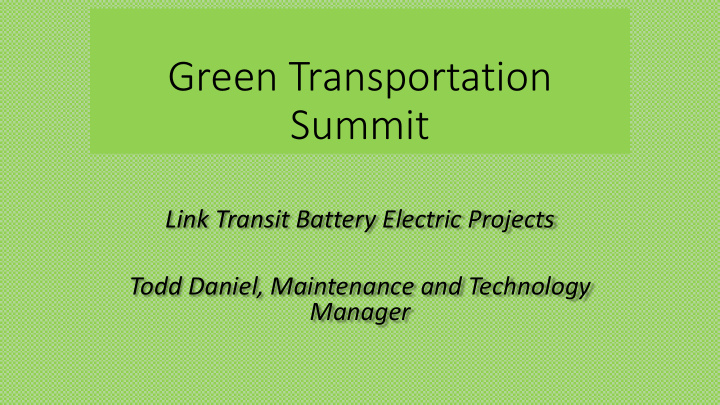



Green Transportation Summit Link Transit Battery Electric Projects Todd Daniel, Maintenance and Technology Manager
LINK’S HISTORY WITH BATTERY ELECTRIC PROJECTS
EBUS BATTERY ELECTRIC TROLLEYS • 2009 awarded TIGGER Grant for 5 Opportunity charged Battery Electric Trolleys • 2010 awarded contract to EBUS Inc. for the development of Fast Charged vehicles designed with water cooled Lithium Titanate (LTO) battery technology • 2011 prototype trolley was delivered with LTO water cooled battery technology • 2012 Fast Charge (GAMMA) Stations were installed at Link’s Intermodal Facility buses were designed to charge at 350 amps 800 volts • 2012 Testing concluded with LTO batteries and decision was made to redesign • 2013 redesign battery technology to Lithium Iron Phosphate (LiFePO4) with lower energy Fast Charging • 2014 LiFePO4 battery technology was placed in revenue service • 2016 Fast Charging was abandoned and trolleys operate half days on slow charging only
EBUS TROLLEY SPECIFICATIONS • 192 Battery Cells • LiFePO4 Iron Phosphate Chemistry • 3.2 Volt-180 Ah • 600 volt system-110 Kwh Battery Capacity • Range 85 miles • Slow Charged @ 50 Kw for 2 hours est. • Trolley weight 15,000 lbs- 19,500 Gross • 22 Passenger plus 1 wheelchair • Currently operating 7 mile routes-15 min freq. • In Circulator Service “with capacity issues” • Bus replacement scheduled for 2019 • Bus meets 7 year 100,000 Federal Standards
EBUS SLOW CHARGER “MULTPLEXER”
BYD PROJECT • 2016 Currently 5 K9S 35’ buses on order funded by 2011 Tigger III Grant • Delivery Nine months behind schedule 1 st bus arrived in January 2017 • Partial cold weather testing occurred in January which included the testing of slow charging, bus start up, systems stability, supplemental coach heating and range • 2016 LoNo Grant awarded for 5 additional 35’ buses to include One Wireless Inductive Charging station • Potential purchase of three addition buses pending cold/hot weather operational performance • 2018 full urban service electrification planned
BYD K9S SPECIFICATIONS • 35 Foot in length • Bus Curb Weight 28,700 Gross Weight 40,700 • 31 Passenger plus 2 wheelchairs • 150 to 175 miles per charge @ 100% SOC to 20% SOC • 270 Kwh • BYD Batteries 12 year unlimited warranty • 160 cells- 3.2 volts per cell @ 290 Ah- 500 volt system • Pre-wired for 200 kW Inductive charging • Specified with diesel fired convection heating
BYD K9S
BYD 85 Kw Slow Charger
Charge Paddles Connected
BYD Slow Charger Switch Gear
Opportunity Charging Options
CONDUCTIVE CHARGING “Mechanical Connection”
IN INDUCTIVE CHARGING Link Transit’s Preferred Option “No Mechanical Connection”
Typical Small Scale In Inductive Charging
Ele lectronics Housed in in Secured Enclosure In Installed in in clo lose Proximity to Pri rimary ry Transmitter
On On-Board Vehicle Secondary ry Receiver In Installation
Component Characteristics of f In Inductive Charging • Power transmission is not hampered by snow or ice • Primary disks are composite sealed, totally waterproof and flush mounted to the concrete surface • Snow removal in the winter will not be an issue • Surface mounting does not present a trip hazard • UL Certified and tested including Electromagnetic certification for pacemakers
With fast opportunity charging after each route, the battery SOC never falls below 50%, even if some charge opportunities are missed or duration is irregular 100%� 90%� Battery State of Charge (SOC) 80%� 70%� 60%� 50%� 40%� If once-a-day depot charging is used, 30%� SOC will decline steadily and driving range will be limited 20%� 10%� 0%� 1� 2� 3� 4� 5� 6� 7� 8� 9� 10� 11� 12� 13� 14� 15�
Things to Consider if Your Contemplating Moving forward With Battery Electric Vehicles and Advanced Charging Technology • Make sure you have Adequate power available on-site • Plan for expansion of services “scalability” • Understand your utilities demand charges and peak power times • Is your staff, Board and the public aware of your plans • Insist on a full training program for your team • Develop a solid First Responder training program for police and fire • Be realistic with key milestone dates • Understand the elements that effect range, Ambient Temp, Geography, dwell time and operator driving efficiency • Emergency power generation “on - site” and “portable” • Plan for capital replacement in the future!
Questions?
Recommend
More recommend